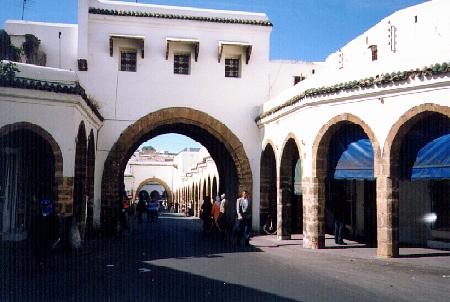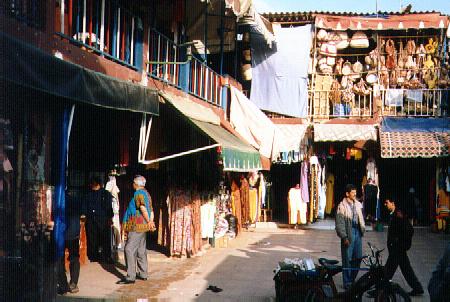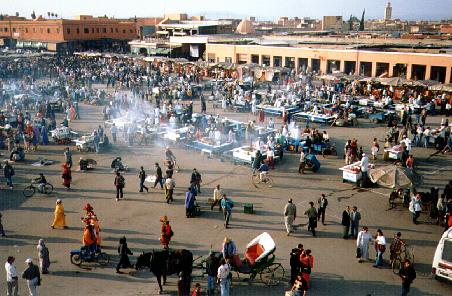
Habous
|

Marrakesh
|

Marrakesh
Place Djeemaa El Fna
|
|
|
Marocco is a colorful mix of African, Islamic, Arab, Berber and European influences. Fes, Marrakesh and Meknes are famous imperial cities. Also famous are the walled Medinas with good carpet shops. Marocco has a very young population (50% under 20 years). The smoking of Kif (cannabis) is an ancient tradition in northern Morocco.
Morocco is a country with a very glorious past. It was conquered by the Arabs in 683 only after long, fierce resistence from the local Berber tribes. It became the heart of the immense Almoravid and Almohad empires, and the beauty of the great cities of Morocco are a witness to this. Three quarters of the people trace their ancestry to the original inhabitants, the Berbers who weathered invasions by the Phoenicians (12th century BC), the Carthaginians (6th BC), the Romans (2nd BC), the Vandals (5th AD), the Byzantine Empire (6th AD), the Arabs (7th AD), the Portuguese (15th), the Spanish (19th) and the French. A third of those still speak the ancient Berber Afro-Asiatic language.
|
Rabat:
Rabat is the capital city of Morocco. It is one of Morocco's four imperial cities. The history of the city goes back to 2500 years during the time of Phoenician exploration.
The city itself was founded by Abd al-Mumin as a camp for his campaign against Spain and later when trying to invade North Africa. Later, the Almohad sultan Abu Yusuf Ya'qub al-Mansur used the city for his campaigns in Spain. He named the city Ribat al-Fath, which meant the Camp of Victory. He built the grand Oudia Gate and the tower of Hassan. After his death however, the fortunes of the city declined. Muslim exiles from Spain later settled in Rabat and Sale in the 17th century. Later on, it became the base of the Salee Corsairs, the most fearsome of the Baraby pirates. Even later, the city came under French control and was made the administrative capital. Ultimately, independence was gained in 1956. Today, Rabat is a modern city, but its eventful historic past shows through. The medina (ancient Muslim town) and millah (Jewish quarter) lie within old fortifications. The 17th century fortress - Casbah des Oudaia lies to the north overlooking the Atlantic ocean, and now contains a museum. Other buildings include the magnificent tower of Hassan, the minaret, ruins of al-Mansur's mosque, archeological museum, and the ar-Rouah city gate. The city also contains the Muhammad V University and the national library.
Rabat is now an important industrial center. Industries present include fruit, fish processing, carpets, leather handicrafts etc. It is connected to other parts of the country by road, and has an international airport.
Tangier:
Overlooking a vast sweeping bay, Tangier is the traditional gateway to Morocco. Though no more than 15 miles across the Straits of Gibraltar from Europe, this is a cosmopolitan city that stands on the threshold of Africa. Its world of soaring minarets and domes, ancient casbah (once the sultan's walled palace and gardens), colourful costumes and animated souks express the rich part-Arab, part-African heritage of a city that has seen occupation by 12 nations since the 5th century.
Agadir:
Poised between the Atlantic and the snow-crowned Atlas Mountains, Agadir is a lively resort set beside a vast beach. The town presents the modern face of Morocco, but one where a pervasive sense of ancient and deep-rooted tradition still lingers - while inland, where the warm Sahara winds blow, the citadel-oasis setting of Taroudant, reflects Berber culture at its most exotic.
Casablanca:
The most cosmopolitan of Morocco's cities, with a palpably French mood, but reflecting the paradox at the heart of Morocco - its unique fusion of ancient and modern, of Africa, Arabia and Europe. The beguiling Casablanca of Bergman and Bogart may be no more - but you'll still find endless interest and enigmas here amid busy boulevards and vibrant bazaars. From here, too, you can visit the historic Imperial City of Rabat, while magical Marrakech is within reach on a full day tour.
Ceuta:
CEUTA, SPANISH MOROCCO: A tiny Spanish city-enclave of just 19 square kilometres on the Moroccan side of the Straits of Gibraltar, ceded to Madrid by the Portuguese over 400 years ago. Ringed by the sea, the hilly streets of duty-free Ceuta have a unique atmosphere and heritage, European yet African, with sights that include the massive 14th century city walls, a pirate's castle, lakes, waterfalls and landscaped gardens.
History:
In the 19th century, the country attracted the colonial ambitions of France, Spain and Germany. The French, who already held Algeria, began their invasion in 1844, while the Germans nearly went to war with France in 1905and 1911 over the Morocccan question. Apart from a small piece of territory which belonged to Spain, Morocco became a French protectorate in 1912. However the anti-French resistance was violent, and the rebellious mountain tribes were beaten only in 1934. At the end of the Second World War, the Moroccan independence movement, with the combined action of the Nationalist Party, the Istiqlal, and of the Sultan Mohamed Ben Youssef, grew stronger. The French decided to follow a hard line, and deposed the Sultan in 1953. He was replaced by Moulay Arafa, who was supported by the French colonials. The exiled sultan became the peoples hero, and Morocco was ready to explode. As soon as the Algerian revolution broke out, France decided to cut its losses and pull out. Mohamed V made a triumphal entry into Rabat on 2nd March 1956, independence day. Since then Morocco has been a constitutional monarchy.
He was succeeded by his son Hassan II in 1961. Hassan, who has enjoyed a largely autocratic rule has conceded a measure of democratisation in the 1996 constitution in order to arrest the spread of Islamic fundamentalism from Algeria and prepare his succession by his son Sidi Mohammed.
Enabling us to improve the quality of the content, if you have additonal information, remarks or suggestions, please share it with us by e-mail.
Last update: 24 April 2008
|